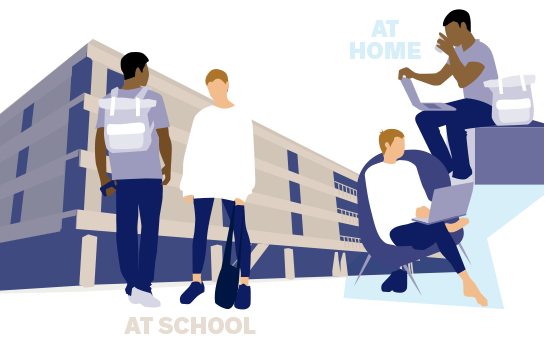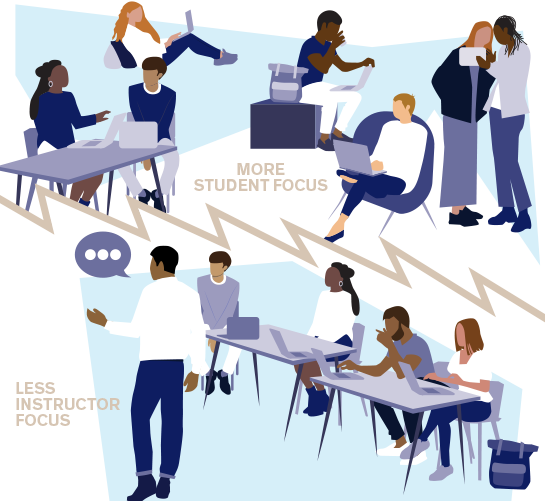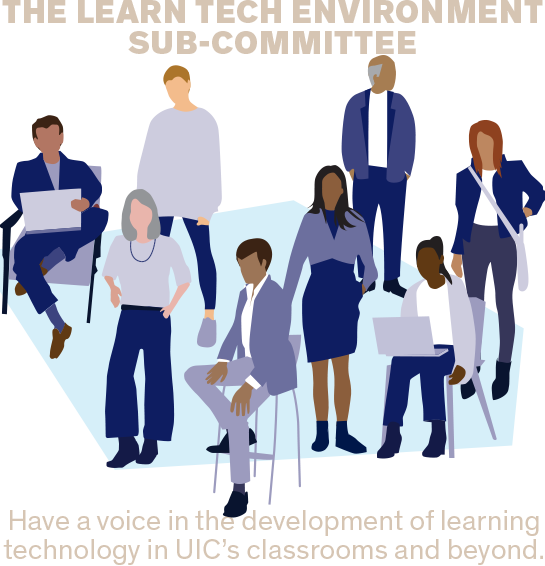Recognizing the Need for Flexible and Engaging Learning Environments
block 1 Heading link

In the wake of the Covid-19 pandemic, higher education faced a shift, forcing institutions to reevaluate their teaching methods and adapt to the evolving needs of students. As education transformed, a spotlight shone on the importance of engagement and flexibility. Through the Higher Education Emergency Relief Fund, or HEERF, the federal government made $30 billion in pandemic-relief aid available to colleges specifically to distribute to their students. HEERF also gave colleges a separate bucket of money they could choose to spend on other purposes.
UIC’s Technological Transformation: Shaping Spaces for the Future of Education
Recognizing the need for flexible and engaging learning environments, UIC embarked on a journey to upgrade its classroom technology. The aim was to establish a hybrid model where lectures and activities seamlessly transcend physical boundaries, benefiting both in-person and remote students. This ambitious endeavor involved a significant investment in classroom infrastructure, including wired and wireless capabilities, IP cameras, and comprehensive audio-video recording capabilities. The technology enables instructors to deliver lectures in their preferred manner while simultaneously recording and streaming content for remote students. Lectures can be accessed on-demand or in real-time, providing students with the freedom to learn at their pace and convenience.
block 2 Heading link

Flexibility Redefined: The HyFlex and Active Learning Models
While the modernization of UIC’s digital learning environment has been transformative, it is only the initial step. UIC recognizes that true flexibility goes beyond technology; it lies in how students engage with the learning process. The next step is to develop and practice Hyflex learning and Active learning, to best use these flexible environments. In a HyFlex environment, students are empowered to choose how they participate in courses. Whether attending classes in person or online, the goal remains consistent – achieving learning objectives. This approach not only acknowledges the diverse learning styles of students but also respects their individual circumstances and preferences.
Active Learning involves strategies that encourage students to take an active role in their learning process. Instead of passively receiving information from a teacher or textbook, students are required to participate in discussions, problem-solving activities, group projects, debates, and other interactive tasks, within a flexible space that supports these activities. This approach is believed to enhance understanding, critical thinking, and retention of the material, as students are more engaged and invested in their learning.
quote Heading link
“Flexible learning modalities are going to help institutions continue to serve the younger, on-campus student populations that many colleges and universities have typically served in years past while also allowing them to explore alternative degree and course models that will appeal to lifelong and off-campus student populations that will increasingly constitute the higher education of the future.”
| 2023 Students and Technology Report: Flexibility, Choice, and Equity in the Student Experience
block 3 Heading link

The Value of Flexible Learning Environments: Empowering Student-Centered Learning
Flexible learning environments have emerged as a potent tool in the quest for student engagement and success. Traditional education often fell short in accommodating the unique learning styles and preferences of students. However, LTS’s approach to developing flexible learning spaces that support HyFlex and Active learning seeks to bridge this gap effectively.
These malleable environments provide numerous benefits:
- Personalized Learning Paths: Each student has their unique way of comprehending information. The flexibility of UIC’s learning spaces caters to diverse learning styles, ensuring that students grasp concepts in ways that resonate with them.
- Enhanced Engagement: Conventional classrooms sometimes struggle to captivate students’ attention. The interactive nature of flexible learning spaces, along with the integration of technology, creates a dynamic and engaging atmosphere that fosters curiosity and participation.
- Improved Well-being: Students’ mental well-being is paramount to their success. Flexible learning environments promote a supportive atmosphere, allowing students to engage comfortably and at their pace. This reduces stress levels and contributes to a positive learning experience.
- Collaborative Learning: Collaborative skills are essential in today’s world. Flexible learning spaces encourage group discussions and teamwork, fostering critical thinking and problem-solving abilities in students.
block 5 Heading link

Sustaining the Momentum: Ensuring Long-Term Benefits
As UIC and institutions worldwide adopt flexible learning environments, it’s crucial to plan for the future. The rapid pace of change regarding technology, necessitates strategies to maintain these spaces’ relevance. Technology refresh cycles, ongoing support, and the involvement of stakeholders are vital to ensure that the benefits of these innovative approaches endure.
At UIC, this commitment is reflected in the creation of a Learn Tech Environment Sub-Committee. Operating under the umbrella of the Information Technology Leadership Council, this entity will collaborate across colleges to strategize, implement, and sustain the university’s dynamic learning landscape. If you are one of the following, we warmly invite you to become a part of this committee:
- An educator who utilizes or holds an interest in active learning practices.
- A staff member involved in the support and integration of technology within your college’s classrooms.
- Someone intrigued by the prospects of classroom technology and eager to contribute insightful perspectives shaping the future of these environments.
To express your interest, kindly complete a brief questionnaire, and we will be in touch promptly.
Flexible learning environments are a testament to the evolution of education in the 21st century. With the pandemic as a catalyst, institutions are redefining the classroom experience to prioritize student engagement, success, and well-being. By combining cutting-edge technology, dynamic learning spaces, and a student-centric approach, we can exemplify the future of education – one where adaptability and innovation pave the way for a new era of learning.